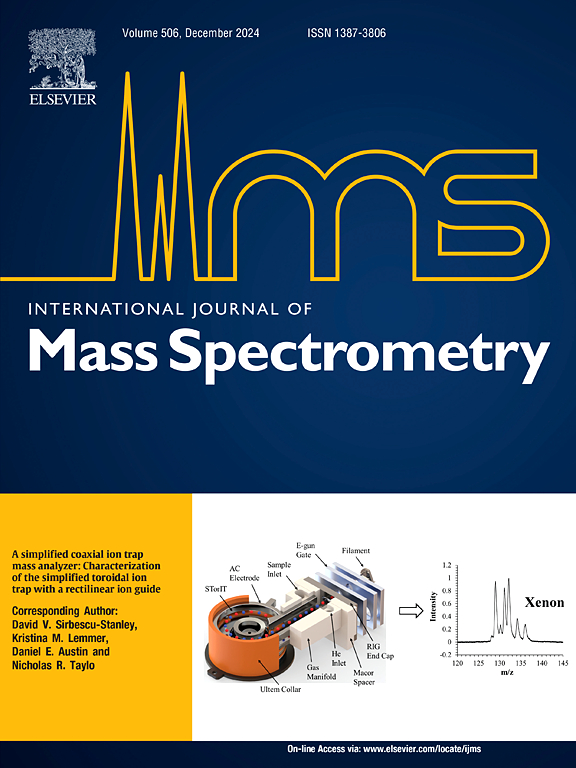甘氨酰甘氨酰酪氨酸自由基阳离子的特征:洞察酪氨酸残基上的β自由基形成和 N-Cα 肽键解离
IF 1.6
3区 化学
Q3 PHYSICS, ATOMIC, MOLECULAR & CHEMICAL
引用次数: 0
摘要
我们研究了甘氨酰酪氨酸 [GGY]-+ 的自由基阳离子的解离和特征,重点是酪氨酸残基上由 β 自由基诱导的 N-Cα 肽键裂解反应。通过将密度泛函理论(DFT)计算与利用低能碰撞诱导解离(CID)质谱和对[GGY]-+中酪氨酸残基的两个β-氢原子进行氘标记的实验研究相结合,我们阐明了β-自由基结构的复杂性及其起源。与含色氨酸的[GGW]-+形成典型的π-自由基前体不同,红外多光子解离(IRMPD)光谱结果显示,β-自由基[GGYβ-]+是从苯氧基自由基[GGYo-]+异构化而来的,自由基分别定位于酪氨酰残基的β-碳和苯氧基原子上。从 [GGYo-]+ 到 [GGYβ-]+ 的异构化势垒为 109 kJ mol-1。本文章由计算机程序翻译,如有差异,请以英文原文为准。
Characterization of glycylglycyltyrosine radical cations: Insights into β-radical formation and N–Cα peptide bond dissociation at the tyrosine residue
We investigated the dissociation and characterization of radical cations of glycylglycyltyrosine [GGY]•+, focusing on β-radical-induced N–Cα peptide bond cleavage reactions at the tyrosyl residue. By combining density functional theory (DFT) calculations with experimental studies utilizing low-energy collision-induced dissociation (CID) mass spectrometry and deuterium labeling on the two β-hydrogen atoms of the tyrosyl residue in [GGY]•+, we elucidated the intricacies of the β-radical structure and its origin. Unlike tryptophan-containing [GGW]•+, which forms canonical π-radical precursors, infrared multiphoton dissociation (IRMPD) spectroscopy results reveal that the β-radical [GGYβ•]+ isomerizes from the phenoxy-radical [GGYo•]+, with the radical localized on the β-carbon of the tyrosyl residue and the phenolic oxygen atom, respectively. The isomerization barriers from [GGYo•]+ to [GGYβ•]+ are <109 kJ mol−1.
求助全文
通过发布文献求助,成功后即可免费获取论文全文。
去求助
来源期刊
CiteScore
3.60
自引率
5.60%
发文量
145
审稿时长
71 days
期刊介绍:
The journal invites papers that advance the field of mass spectrometry by exploring fundamental aspects of ion processes using both the experimental and theoretical approaches, developing new instrumentation and experimental strategies for chemical analysis using mass spectrometry, developing new computational strategies for data interpretation and integration, reporting new applications of mass spectrometry and hyphenated techniques in biology, chemistry, geology, and physics.
Papers, in which standard mass spectrometry techniques are used for analysis will not be considered.
IJMS publishes full-length articles, short communications, reviews, and feature articles including young scientist features.

 求助内容:
求助内容: 应助结果提醒方式:
应助结果提醒方式:


